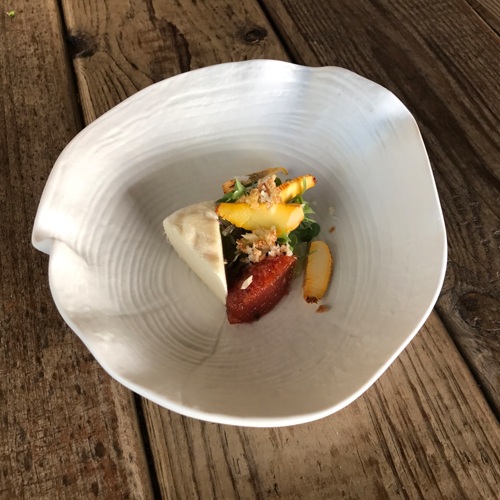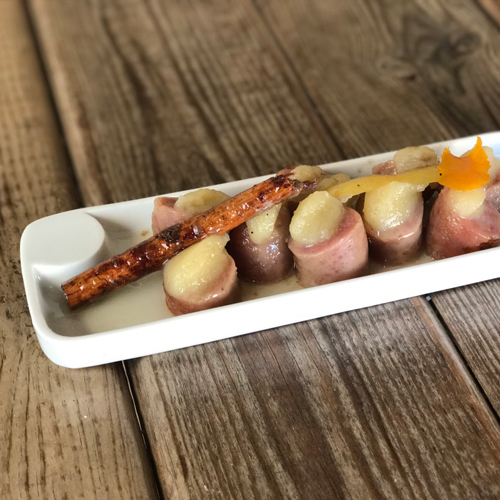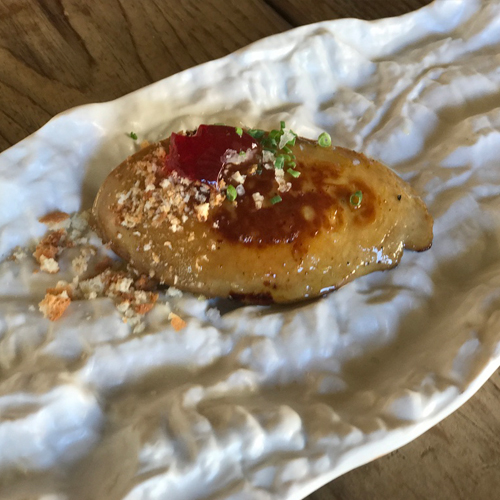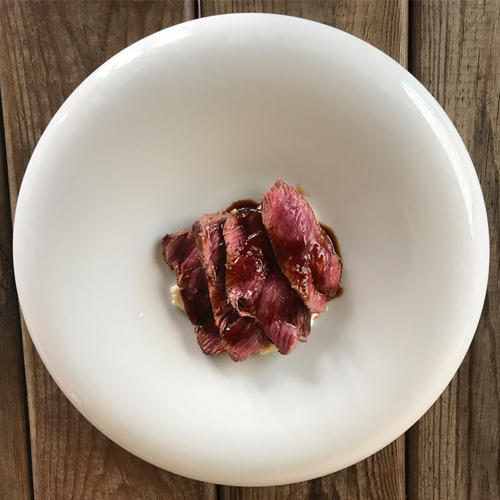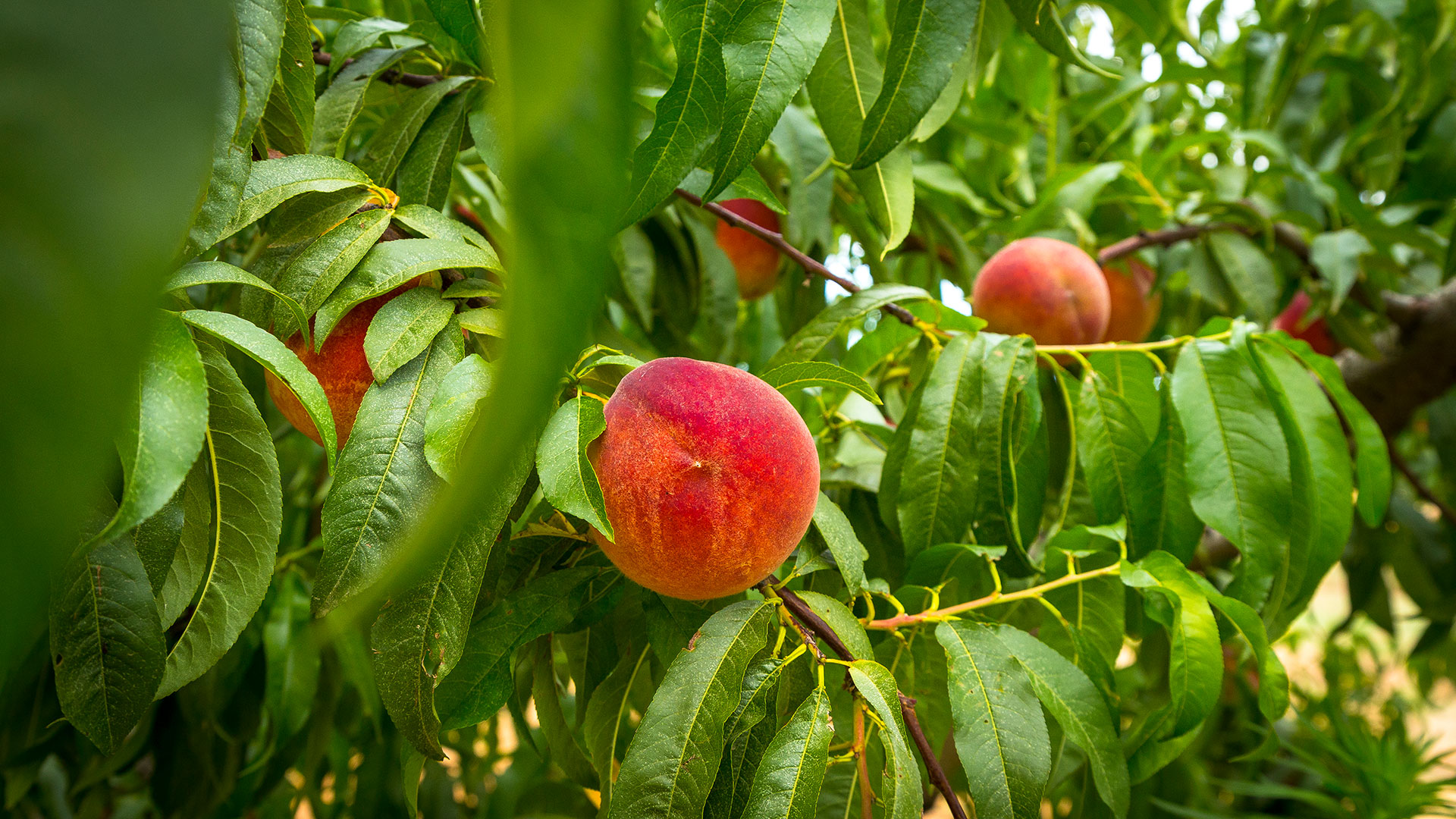
When working the allotments provided a workout for our parents and grandparents, and when families and neighbours could no longer keep up with eating all the fresh food produced, then it was time to start preparing the preserving jars. Many people still maintain the healthy and sustainable custom of making vegetable preserves: broccoli and the Girona bitxo – a greenish-yellow pepper – preserved in vinegar, tomato sauces, whole tomatoes, sweet jams from a single fruit or mixtures of various fruits and vegetables, secret recipes or those created ad hoc, and, towards the end of summer, mushrooms preserved in brine.
In fact, thanks to the culinary and gastronomic awakening we have been experiencing recently, many homes now prepare bases and sauces in advance, such as sofregit (slow-braised onion and garlic) and samfaina (similar to ratatouille), broths and smoked meats, which are preserved in jars sterilised in a bain-marie or frozen. Home-cooked pre-prepared food is a growing market in the retail sector, featuring new and innovative ready-to-eat ideas, some inspired by home cooking, and great traditional dishes.
The world of preserves has experienced growth in all areas: homemade, artisan and industrial. Today we find small artisans who have expanded alongside industries that have opted for high quality traditions, thanks to technological advances. Innovations stand out in terms of new flavours, new products and the quest for healthier products and more sustainable packaging.
Preserves with the 2023-2024 Girona Excel·lent seal
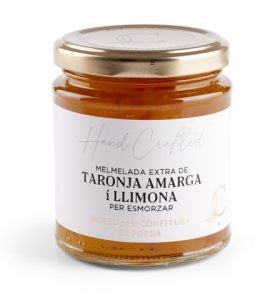
Bitter orange and lemon jam
Georgina Regàs was one of the great ladies of Catalan gastronomy with a great business mind. She passed away in 2022, at the age of 89, and has left an immense bibliographic legacy. In 2004, she opened the Museu Confitura (Jam Museum) in Torrent, her last project. One day in 1975, she was inspired by a lemon tree to make jam. Made with fruit from Santa Cristina d’Aro, in the Baix Empordà region, this jam is the legacy of the first jar that Regàs produced. It is sour and bitter: the acid of the lemon enhances the bitterness of the orange, while the fruit peel adds texture. In 2022, it won over the jury of the Dalemain World Marmalade award in England.
Company: Museu Confitura SL

Green plum jam
San Joan plums and greengages are fruits that define the freshness of summer. Many orchards and gardens have plum trees of these varieties and hundreds of green plum hybrids born spontaneously from seeds scattered by happy people. This traditional jam is made solely with natural ingredients, from green plums harvested in the counties of Girona. Its creators recommend adding it to salad dressings and meat sauces; to use it to make cheesecakes, or to eat it as part of a hearty winter lunch for a reminder of summer.
Company: GB Artesanos Gastronómicos SLU
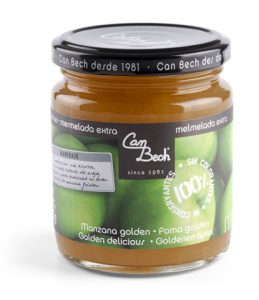
Golden Delicious jam
The Golden Delicious apple is the most classic and versatile of all cultivated apples. Raw, cooked alone in a compote, baked whole, or as a seasoning for meat dishes. This jam is made just as we would at home: 60% Golden Delicious apples, sugar, lemon juice and cinnamon. It goes well with both sweet and savoury dishes. It can be eaten with bread or as an accompaniment to yogurt, fresh cheese or even some mature sheep’s cheese. It is also suitable for making cakes or to serve with roast meat or the traditional botifarra dolça.
Company: GB Artesanos Gastronómicos SLU
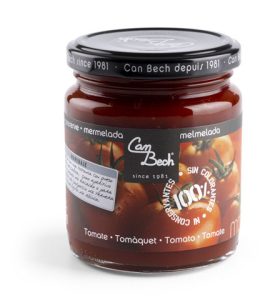
Tomato jam
Tomato jam is only made in the summer. This classic preserve from the vegetable gardens of Girona province dates back to when everyone had an allotment and the surplus tomatoes were used to make sweet and savoury preserves for the whole year. The jam is cooked with sugar until it reaches a firm texture. At Can Bech, located in Fontanilles, they recommend eating it on toast with goat’s cheese, with a chunk of cod, or with a slice of beef carpaccio with a rocket leaf. They also suggest using it as an ingredient in a Bloody Mary cocktail.
Company: GB Artesanos Gastronómicos SLU
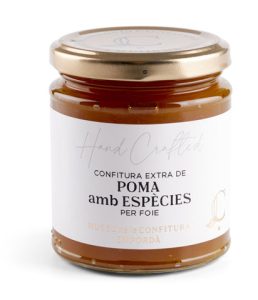
Spiced apple jam
The Museu Confitura in Torrent became a sanctuary for fans and apprentices of the exquisite art of preserves from the moment it opened. The jams are made by hand in the traditional way, but with a willingness to investigate and a touch of daring. This jam is based on the classic Girona Golden Delicious apple, to which turmeric, cinnamon, cloves, star anise, pink pepper, lemon and cane sugar are added. Such a spicy jam is ideal on sweet bread for a morning or afternoon snack, or even to accompany foie gras.
Company: Museu Confitura SL
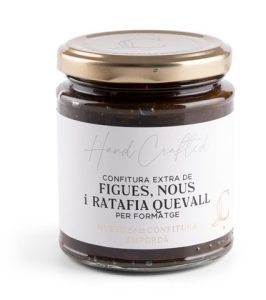
Fig, walnuts and ratafia jam
Dried figs and walnuts play an important role in postres de music (musician’s dessert). And ratafia is one of the traditional pairings for this dessert. In addition, well-chilled ratafia is ideal to accompany freshly picked figs. This fig, walnut and ratafia jam sums up Catalan gastronomic culture. At the Jam Museum, they use figs from small producers in the Empordà region and ratafia from Licors Quevall in Llançà.
Company: Museu Confitura SL
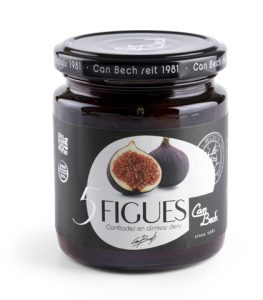
Candied figs in syrup
Candied figs are a classic. Specifically, these whole figs in syrup are at the origins of Can Bech and still today are the company’s star product. The figs come from plantations in Murcia, where they are grown exclusively for the Bech family. They are selected based on their size and are cooked in three stages to obtain a succulent and delicious candied fruit.
Company: GB Artesanos Gastronómicos SLU

Plums in Empordà Garnatxa syrup
Fruit in syrup is a traditional Mediterranean preserve. In general, this fruit does not contain alcohol, but in many places they like to preserve it in liqueurs, wine spirits or wine. Chef Antoni Izquierdo makes plums with lemon, orange, sugar, cinnamon and red Garnatxa wine and recommends using them in either sweet or savoury dishes. He says they are excellent to serve with mi-cuit foie gras, curd cheese or ice cream. One of the highlights of these plums is the syrup itself, made from Empordà Garnatxa wine, lemon and orange peel, sugar and cinnamon.
Company: Antoni Izquierdo Cruellas

Quince with Madagascar bourbon vanilla
Can Bech, in Fontanilles, has come up with a new way of eating quince, one of the ingredients of traditional snacks and one of the classic pairings with cheese. This is a sweet sauce made with quince and Madagascar bourbon vanilla, designed to pair with all kinds of cheeses. It is presented in a glass jar, very far from the traditional format of a gelatinous block to be cut with a knife.
Company: GB Artesanos Gastronómicos SLU
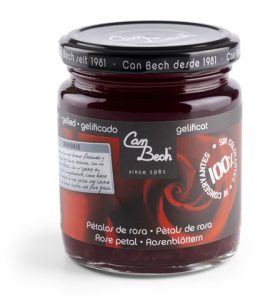
Rose petal jelly
Made with natural rose petals, this jelly has a fresh and aromatic flavour and represents Can Bech’s tribute to flowers. It is packaged and pasteurised (at 80-90 °C) to guarantee its conservation. Pair with fresh cheese or parmesan, with plain ice cream or fresh yogurt. It also makes a great accompaniment to a foie gras canapé or dark chocolate in a cake. It is ideal for preparing a Cosmopolitan cocktail with roses.
Company: GB Artesanos Gastronómicos SLU
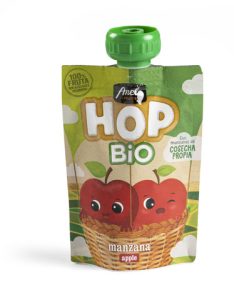
Hop Bio apple juice
Safrunat presents its 100% natural apple purée in a drinkable format. This format offers a convenient way to eat fruit, since the flexible packaging makes it easy to drink or sip the contents. Hop Bio apple juice is made with fresh Golden Russet apples from organic orchards in Fornells and Ventalló. For half a century, the family business, Safrunat, has had apple and pear plantations spread across the counties of Empordà, Gironès and Selva.
Company: Safrunat, SL

Quim Matas’ samfaina
This ratatouille-style dish called samfaina is known as xamfaina in the counties of Girona. It is a typical summer dish that is usually prepared and preserved when the family and neighbours cannot keep up with eating all the fresh produce from their allotments. From his workshop in La Bisbal, Quim Matas makes his samfaina with aubergines, courgettes, peppers, Figueres onions, tomatoes and extra virgin olive oil. With consumers in mind, he does not add any salt and it is, of course, a vegan product. It is great for dipping bread and for mixing with boiled rice, chicken, rabbit, lamb, cod or tofu.
Company: Quim Matas Teixidor
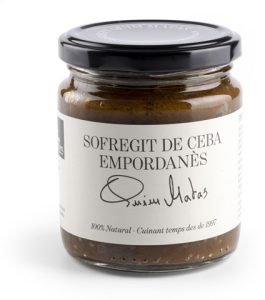
Empordà onion sofregit – Quim Matas
A sofregit of onions and olive oil is the most authentic bedrock of Girona cuisine. A sofregit is understood to be the result of sautéing the onion very slowly to break down and concentrate its sugar content until it is caramelised and brown. Quim Matas, a butcher in La Bisbal since 1977, carries out this delicate process for 12 hours with onions from Figueres and extra-virgin olive oil. This product is just a base, and Quim Matas was the pioneer in making it available to everyone everywhere.
Company: Quim Matas Teixidor
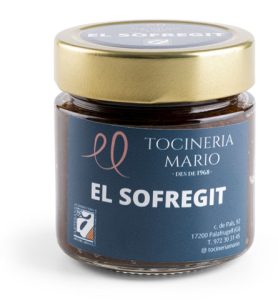
El sofregit – sofregit of onion and tomato
Eduard Gaviña Bartrina started working in Can Mario, a butcher’s shop that opened in 1968 in Palafrugell, when he was just 12, helping with small tasks at the counter – putting customers’ orders in bags, returning the change, etc. At the age of 14 he was already working in the workshop tying black and white botifarres. In 2008, when Mario Mascaròs, the former owner, retired, he took over. He prepared food to take away, like most butchers, but during the coronavirus pandemic he started cooking and packaging sofregits, like this sautéed onion and tomato classic.
Company: Eduard Gaviña Bartrina
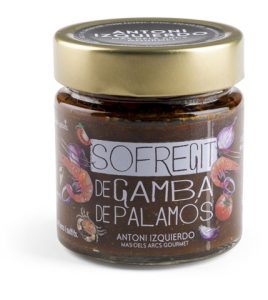
Palamós prawn sofregit
The best sofregit to date for cooking seafood has been created by Antoni Izquierdo, owner and chef of the Mas dels Arcs restaurant in Palamós. This sofregit, the result of years of work at his restaurant, is made with Figueres onions, certified Palamós prawns, crab, fresh tomatoes, olive oil, sugar and salt. It is ideal for cooking Empordà dishes successfully: fish and shellfish rice dishes, fideus, rossejat de fideus, suquets, sarsueles, and surf’n’turf soups and stews.
Company: Company: Antoni Izquierdo Cruellas
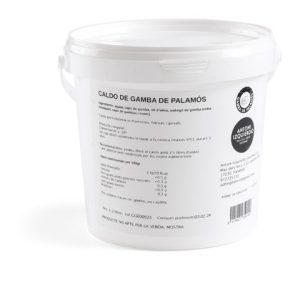
Palamós prawn stock
Antoni Izquierdo is the chef who knows best how to cook with Palamós prawns. Using only Palamós prawns, olive oil, salt, mineral water and his prawn sofregit, he has created a delicious stock to give rice, fideuades and stews an intense prawn flavour. This stock is very concentrated and for this reason he recommends adding 50% water to make a very good quality broth.
Company: Company: Antoni Izquierdo Cruellas
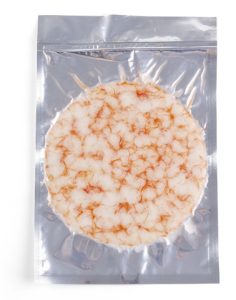
Palamós prawn carpaccio
The Palamós prawn must be the most popular of all the prawns caught in the eastern Mediterranean. Antoni Izquierdo, a specialist and lover of this most famous prawn, prepares them in a completely natural and artisanal way: very thin slices of freshly-caught prawn of the Aristeus antennatus species, considered the finest species of prawn from a gastronomic point of view. This carpaccio can be eaten as an appetizer or to top off a prawn rice dish made with his sofregit and Palamós prawn stock.
Company: Company: Antoni Izquierdo Cruellas

Spring-caught anchovy essence
During the process of preserving anchovies in brine, a liquid emerges that our ancestors called liquamen or garum. The anchovy caught in the spring months, when oily fish is at its plumpest and tastiest, is aged for longer in the containers, so the liquid it releases contains the finest essence of the sea. Any impurities are then filtered out, and Callol Serrats bottles the juice that is strained off, a flavour enhancer with a subtle marine aroma.
Company: Company: Fill de J. Callol i Serrats, SL
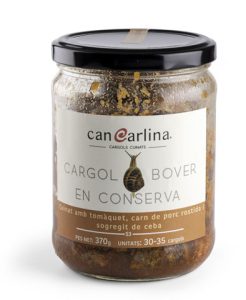
Bover snail, tomato, roast pork and onion sofregit
The Brunsó family has had a stall at the Lleó Market in Girona for three generations, where they sell live snails and garden produce. In 2014 Ramon Brunsó founded Mas Can Carlina, SL. In 2017, they started selling cooked and chilled snails. And in 2020 he came up with the preserved snail, cooked with oil, spices, herbs and salt water. All the buyer has to do is dress them, eat them with sauce or cook them. The company is now offering the same Bover snail prepared with a tomato sauce, roast pork and onion sofregit.
Company: Mas Can Carlina, SL

Bitxo de Girona – pickled peppers from L’Hort de les Mulleres
The preserved pepper is the king of pickled vegetables. This pale green or light-yellow pepper is a must in winter salads and an essential accompaniment to hearty meals. Verdures de la Canya prepares this preserve according to a family recipe. The pepper is pickled whole for three weeks and then chopped and packed in brine and vinegar. Verdures de la Canya is a family business that has been producing seasonal vegetables since the 1960s.
Company: Verdures de la Canya, SL

Cod brandade
Cod has been a staple in the kitchen since the time, from the seventeenth century or even earlier, it used to come as a salted or dried preserve, which meant that everybody could eat it since it could be transported anywhere. Thus, cod brandade, or cod emulsified with garlic and oil, is a traditional dish from classical cuisine, at least the contemporary version of this preparation. El Salt del Sallent makes their cod brandade with 55% cod, potato, oil and garlic, and it has a lovely texture. Precuinats El Salt del Sallent is an Olot-based company that specialises in food production, notably traditional products.
Company: Precuinats El Salt del Sallent SL

Croquettes of La Xiquella blue cheese and quince
For this business founded in 2022 in Puigpardines, next to the Verntallat farm shop in Vall d’en Bas, winning a competition in 2023 has meant that things got off to a great start. The cook, Raquel Vila, and David Diví are the creators of these delicious blue cheese and quince croquettes. Eminently local, they are made with blue cheese from La Xiquella (Sant Esteve d’en Bas), quince from La Codina, flour from Girona, milk from Vall d’en Bas, Cadí butter, and olive oil. To achieve the creamy consistency and the crispiness that characterises these croquettes, they need to be fried in oil at 180 ºC.
Company: Productes Artesants Divila S.C.
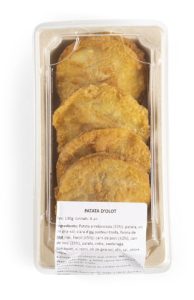
Olot potatoes – category
Olot or Bretcha potatoes are the most universal dish in the gastronomy of the capital of the county of Garrotxa. These stuffed potatoes were first created in La Deu restaurant in 1943, when the mayor of Olot and president of the Diputació de Girona, Pere Bretcha Galí, invited the civil governor and he asked for something different from the usual cannelloni or rice. An aunt from La Deu and a relative from Can Fermín de Besalú, on their honeymoon trip to Mallorca, had eaten some potatoes stuffed with meat which served as their inspiration for cooking very thinly slices of potato stuffed with shredded roast meat, battered with beaten egg and fried in oil. El Salt del Sallent prepare the potatoes so they simply need to be baked, fried or grilled.
Company: Precuinats El Salt del Sallent SL
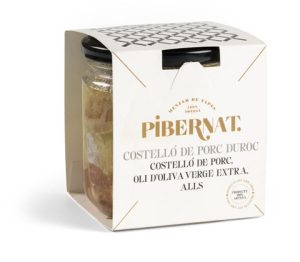
Duroc pork ribs – category
Pibernat is a small family business in Les Tries neighbourhood in Olot that specialises in preserves, with a production capacity of around 120 jars per day. This Duroc rib is cooked at a low temperature for many hours in the traditional way: confit in oil and flavoured with rosemary. The result is a deliciously soft, succulent, aromatic meat, like the old confits that were made in rural kitchens in earthenware pots after a pig was killed for domestic use. The rib is reheated in the pan or in the oven at 200 ºC for 5 minutes, or in the microwave oven for 45 seconds at 700 W.
Company: Pibernat Alimentària, S.L.

Salted anchovies
Glass jars are the default format for the salted anchovies produced by Callol Serrats. These top-quality anchovies are aged for a minimum of 12 months to achieve their characteristic appearance, texture, aroma and flavour. Once the quality of the anchovies has been validated, they are packaged for commercial distribution. At home, consumers need to desalt and season with oil however many anchovies they want to eat, leaving the rest in the jar covered with their own salt.
Company: Company: Fill de J. Callol i Serrats, SL
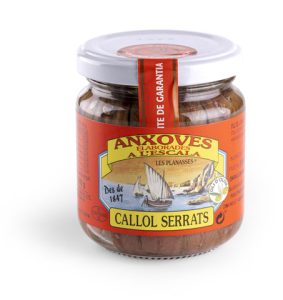
Anchovies in oil
Consumer habits and the way we eat have changed so much that anchovies, like many other gastronomic delights, are now sold ready to eat. Half a century ago, if they were not prepared at home, anchovies were bought by the unit, desalted, the central bone removed, dressed and… to the table! Today, Callol Serrats sells the highest quality anchovy fillets in olive oil, packaged in glass jars. Ready to serve and eat.
Company: Company: Fill de J. Callol i Serrats, SL

